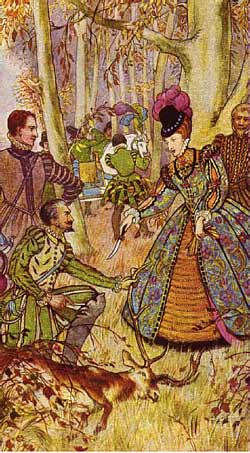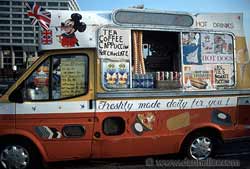|
Food in History of Britain

Some Russians think that the main food of an Englishman is porridge. What do the British eat, in fact? Can you give the typical menu of the British (English, Scottish, Irish)?
At one time, English food did not vary greatly, except between classes. By this I mean that people of a certain class tended to eat similar things, but their food would be very different from that of another class. Long ago, rich people ate mostly meat as vegetables were considered to be fit only for peasants and animals. As a consequence, the poorer classes often had a healthier diet and much better teeth than their lords and masters. Meat was supplemented with bread: white for the rich and coarser1, brown bread for the lower classes. As the bread was often baked directly on hot ashes in an oven, the bottom of the loaf would probably be burnt and dirty, so the loaf would be cut horizontally before being served to the rich people, the bottom half being used as a plate and only the top part eaten. After the meal, this dirty lower half would be given to servants, beggars2, etc. From this we get the common expression the upper crust denoting richer people.

Mr David Wright, kindly agreed to answer our questions
Generally, the ordinary water was unfit for drinking so people would drink weak alcoholic beers and ales, or wines from abroad if they could afford them.
Of course, there were frequent times of famine3 when the harvests would fail due to bad weather or pests and diseases in the crops4. Then the poorer people would have very little to eat at all. Before the days of refrigeration and modern storage, food would be seasonal. Many of the farm animals would be killed before winter as there would be no fodder5 for them when the grass was not growing. The meat from these would be salted or pickled6 in vinegar7 and stored in barrels for later use. Sailors going on long voyages would subsist for months on salted beef and hard biscuits. Meat would therefore be in short supply8 during the winter and early spring months and so more fish and birds would be eaten. To provide these, many big houses had fish ponds and dove-cotes9. Ice would be cut from the ponds and lakes when they were frozen and stored in specially insulated10 buildings for use when the weather was hotter, but again, only the rich would have these. Poor people would have to make do with stored roots vegetables and, perhaps some salted or smoked meat or fish, such as bacon. Obviously, people who lived near the sea would eat more fish and seafood, including seaweed11.
Once England became a great maritime power, foods from far distant countries became more available, particularly food from parts of the Empire, such as spiced and curried12 dishes from India.
When I was young, the Second World War was either in progress or had just finished, so all kinds of food were in short supply and so foods that were strange to us were introduced, like whale meat and a peculiar fish called “snook”13, but these never became widely eaten. As soon as possible, people reverted to eating the kinds of food that were eaten before the war.
 Typically, a good breakfast, eaten before work would consist of cereal and milk, and fried egg, tomatoes, sausage, bacon and bread, followed by toast and marmalade, all washed down with a couple of cups of tea. Lunch might be bread, cheese and pickle14, with afternoon tea of more bread and butter, with cakes. A full dinner in the evening might be soup, followed by meat, potatoes and two eggs with a pudding afterwards. The traditional Sunday dinner, which was the only time most people had time for a proper meal would probably be eaten at around mid-day, but customs varied greatly. Certain regions had foods which were particular to them. Londoners were known for their fondness for oysters15 and jellied eels16, whereas in the north, tripe (ox stomach or intestines) was considered a delicacy. People from other regions considered tripe to be worthless rubbish and the word is often used in a metaphorical sense, as to talk tripe17.
Typically, a good breakfast, eaten before work would consist of cereal and milk, and fried egg, tomatoes, sausage, bacon and bread, followed by toast and marmalade, all washed down with a couple of cups of tea. Lunch might be bread, cheese and pickle14, with afternoon tea of more bread and butter, with cakes. A full dinner in the evening might be soup, followed by meat, potatoes and two eggs with a pudding afterwards. The traditional Sunday dinner, which was the only time most people had time for a proper meal would probably be eaten at around mid-day, but customs varied greatly. Certain regions had foods which were particular to them. Londoners were known for their fondness for oysters15 and jellied eels16, whereas in the north, tripe (ox stomach or intestines) was considered a delicacy. People from other regions considered tripe to be worthless rubbish and the word is often used in a metaphorical sense, as to talk tripe17.
A dish which has remained very popular is fish and chips, usually a white fish such as cod18 or haddock19, deep fried in batter20. This is occasionally cooked in the home, but is more usually bought from a fish and chip shop or chippy, sprinkled21 with salt and/or vinegar and carried home (or eaten on the way) wrapped in old newspapers.
There have always been large populations of immigrants from other countries in England, particularly since the war, and these people have brought their own favourite customs and foods with them, e.g. Caribbean, Indian, and Chinese. Many of these are now more commonly eaten by English people than the traditional foods. Nowadays, families tend not to eat together as they used to, so snack foods are popular and, of course, we have McDonalds!
Many of the cities here have districts where there are many restaurants specialising in particular ethnic foods. In places like Manchester or London, you could find every sort of food, I expect. Now that people have generally more money than in the past, a much greater variety of food is eaten and it’s hard to say what is now typically English.
 Probably far more curry is eaten with chips and fish. It is safe to drink the domestic tap water in England, but much more coffee and wine are drunk than before.
Probably far more curry is eaten with chips and fish. It is safe to drink the domestic tap water in England, but much more coffee and wine are drunk than before.
What about the rest of the UK? The porridge that you mentioned is particularly associated with Scotland where oats22 are grown in preference to wheat, due to the harsher climate. They also make oats into small, hard biscuits called oatcakes and use it in the recipe for a strange (to me) food called haggis, which I believe is a sheep’s stomach stuffed23 with oatmeal, herbs and goodness knows what else!
When you mention Ireland, we immediately think of potatoes which are suited to their cool, wet climate. They were so dependent on potatoes, that when the crop was devastated by a blight24, many hundreds of them died, despite millions of pounds of famine relief being sent from Great Britain. As a result of this famine and the associated poverty, thousands of Irishmen emigrated to the United States.
To be continued
1 coarse – грубый
2 beggar – нищий
3 famine – голод
4 crops – зерновые (культуры)
5 fodder – корм для скота
6 pickled – маринованный
7 vinegar – уксус
8 in short supply – дефицитный
9 dove-cote – голубятня
10 insulated – изолированный
11 seaweed – морская водоросль
12 curried – приправленный карри
13 snook – снук (рыба)
14 pickle – (зд.) соленый (маринованный) огурец
15 oyster – устрица
16 jellied eel – заливной угорь
17 to talk tripe – говорить ерунду
tripe – рубец (часть желудка жвачного животного)
18 cod – треска
19 haddock – пикша (рыба)
20 deep fried in batter – запеченный в тесте
21 sprinkled – посыпанный
22 oats – овес
23 stuffed – фаршированный
24 blight – болезнь растений
Читать еще в этой рубрике:
Читать еще в этом номере:
|
|











